This post may include affiliate links. Thank you for your support.
If you’re looking for the perfect easy weeknight dinner, look no further than this Greek Shrimp Saganaki recipe. Featuring succulent shrimps baked in a rich, tangy tomato sauce studded with crumbled feta cheese and briny olives, this one-pan seafood dish is easy to make and ready in just 30 minutes!
Featured comment: O.M.G. This dish is most awesome. Scaled recipe for 2 servings and appreciated the capability to do that. The depth of flavour is amazing, even though I did forget to include the fresh basil. Grated the lemon over the oil to allow all the lemon fragrance/oil to flavour the marinade. Have cooked a wide variety of recipes and this was exceptional.” – Carol
Continue to read on for simple tips and tricks for making this Greek shrimp bake. And, don’t miss the comprehensive step-by-step photographs showing you exactly how easy this dish is to make at home!
Update: This recipe was originally published in April 2021. I made updates to the article below to include more information about baked shrimp with tomatoes and feta. I also added step by step photos to show you *JUST* how easy this shellfish dinner is to prepare at home!
Hi, friends! I hope you are ready for some seriously scrumptious shrimp, because today’s recipe is a total winner-winner. Once bite and you’ll want to make these plump, zesty, flavorful Greek lemon shrimp over and over again!
Table of Contents
About this shrimps saganaki
This quick and easy shrimp recipe is bright, light and healthy, yet hearty and bursting with bold Greek flavors!
This recipe features plump shrimp marinated in zippy lemon zest and then baked in a savory, chunky tomato sauce spiced with delicate shallots, pungent garlic, aromatic Greek seasonings, briny olives, tangy feta and a splash of white wine. A generous sprinkling of fresh herbs and a squeeze of bright, fresh lemon juice finish this prawn dish off beautifully!
But, this Greek baked shrimp isn’t just incredibly flavorful, it’s also so simple to prepare and made in just one pan with easy to find ingredients! It’s the perfect dish when you want to serve an appetizer that is sure to impress! And, it’s equally as delicious paired with orzo, rice or pasta for a fast weeknight dinner for your family!
Looking to keep things easy, healthy and delicious?! This baked shrimp and feta saganaki recipe is for you!!
Why you’ll love this Greek recipe
- SO flavorful: This dish is bursting with delicious flavor! From the plump, juicy shrimp to the rich, savory tomato sauce and tangy, melty feta, this recipe is anything but boring or lacking in flavor!
- Easy to find ingredients: This modern take on traditional Greek shrimp uses easy to find ingredients to create a dish that is truly irresistibly delicious!
- One pan: From cooking to serving, these saucy shrimp are truly a one pan wonder!
- Make ahead: You can easily make the tomato sauce ahead of time! When you are ready to eat, all that’s left to do is top the sauce with shrimp, olives, feta and bake – making this an easy 8-minute dish!
- Versatile: These Greek shrimp are perfect for every occasion! From elegant entertaining to easy family dinner, these shrimp are always a hit!
If you’re looking for more delicious Greek dinners, be sure to try these recipes next: Oregano Chicken with Zucchini Noodles, Chicken and Moroccan Couscous, Mediterranean Chicken Hummus, and Greek Pasta with Chicken.
What does saganaki mean?
Saganaki refers to a category of traditional Greek appetizers named after the pan in which they’re cooked and served. A saganaki or sagani pan is a small, heavy-bottomed frying pan (skillet) with two handles for easy carrying and serving.
The most common Greek recipes made in a saganaki pan include cheese saganaki, mussels saganaki, and shrimp saganaki. Greek saganaki recipes are best when served right in the skillet with plenty of crusty bread for scooping, dipping and mopping!
What is shrimp saganaki?
Shrimp Saganaki, also known as garides saganaki or seafood saganaki, is a traditional Greek dish consisting of shrimp cooked in a savory tomato sauce with feta. This one-pan baked shrimp dish with tomatoes and feta is usually served as an appetizer with plenty of artisan bread for sopping up the delicious, rich tomato sauce.
What’s in saganaki shrimp?
This greek shellfish recipe ingredient list may look long at first glance; however, all of the ingredients are either easy to find or pantry staples.
Ingredients you need to make Greek shrimp saganaki
- Oil: You will need 4 tablespoons of olive oil for sautéing. Use a good-quality extra virgin olive oil for the best flavor!
- Shallots: Four large shallots add a delicate and slightly sweet onion flavor. You can substitute any onion – yellow, white or red – if you prefer a more pungent onion taste.
- Aromatics and Seasonings: A combination of fresh garlic, greek seasonings, red pepper flakes, kosher salt, and ground black pepper all provide a ton of flavor. Be sure to purchase fresh garlic and peel/mince it yourself for the best punchy flavor (those containers of pre-minced garlic are lackluster in flavor!)!!
- Wine: Traditional saganaki uses Ouzo, however that liquor can be difficult to find in the states. I’ve swapped it out for a dry white wine, which lends a beautiful complexity to the tomato sauce. (See below for wine options.)
- Tomatoes: Two cans of fire roasted tomatoes add a delicious earthy, rich and smoky tomato flavor.
- Honey: A heaping tablespoon of honey provides a touch of sweetness which beautifully balances out the tangy flavors!
- Shrimp: You need 1 to 1 ½ pounds of extra-jumbo (16/20) shrimp. Make sure you use good-quality shrimp: wild American or Argentinian shrimp are best if you can find them. Frozen shrimp are great! Just make sure you thaw them and peel and devein the shrimp before proceeding with the recipe! (Scroll down to read a few tips on baking shrimp.)
- Lemon: The zest of one whole large lemon provides the perfect pop of zesty flavor to marinate the greek shrimp saganaki. Make sure you only use the zest, and not the juice, as the lemon juice will cook the crustaceans!
- Cheese: Crumbled feta cheese is one of the ingredients that makes this dish really special. Use a high-quality Greek feta cheese if you can. (See below for substitution ideas.)
- Fresh Herbs: While totally optional, I highly suggest you don’t skimp on the fresh herbs! A combination of basil, mint, and/or fresh parsley add a pop of herbaceous flavor that really enhances this dish. (Tip: Make sure you’re storing your herbs properly for the best flavor.)
Recipe variations
Want to make some changes to this dish? No problem! This Greek shrimp recipe is pretty flexible! Feel free to substitute or add ingredients based upon what you love or prefer! Below are a few ideas to get you started.
- Cheese: Greek sheep’s milk feta is the traditional ingredient for saganaki shrimps. Greek feta is semi-hard in texture with a rich taste and a salty, tangy and slightly lemony flavor. Not a fan of feta? Try using Halloumi (a semi-hard tangy, salty Mediterranean cheese) or Graviera (a sweet and nutty hard yet mild Greek cheese).
- Tomatoes: If fresh summer tomatoes are in season, swap out the can of tomatoes for ripe ones!
- Avocado: Dice up an avocado and sprinkle it over greek shrimp dishes before serving for an extra layer of creamy flavor.
- Olives: While entirely optional, I highly suggest adding Kalamata olives to this greek shrimp bake. Their beautiful, distinctive wine-like and slightly fruity flavor adds a beautiful layer of richness.
- Wine: You can use any dry white wine you love for this recipe. However, I always recommend selecting a wine you actually like to drink! Chardonnay, Pinot Gris, Pinot Blanc and Sauvignon Blanc are all great options, just steer clear of anything too fruity (Rieslings) or too woody (some Chardonnays). Or are you looking to make authentic shrimp Saganaki? Substitute the white wine for Ouzo, a dry anise-flavored liquor. Can’t find Ouzo? Try using Sambuca!
- Seasonings: No Greek spice on hand? No worries, just swap in cumin and Mediterranean oregano.
How to make this Greek shrimp recipe
This shrimps saganaki recipe is a one-pan meal that’s so incredibly easy to make at home!
- Marinate the shrimp: Place the shrimp in a large mixing bowl. Drizzle with oil and lemon zest. Season with salt and pepper. Toss gently to evenly coat the shrimp and set aside.
- Sweat the shallots: Heat oil in a large oven-proof skillet over medium-low heat. Add the shallots and cook, stirring occasionally, until soft. Add the garlic, cumin, crushed red pepper flakes and oregano. Season with salt and pepper. Cook, stirring, until fragrant, about 1 minute.
- Add wine, then tomatoes: Add the wine to the pan cook 2 minutes. Add the drained tomatoes, ¾ cup of the tomato juices and the honey. Stir to combine. Bring the mixture to a gentle boil, then immediately reduce to maintain a gentle simmer. Cook, stirring occasionally, for 12-16 minutes. Remove the tomato sauce from the heat.
- While the tomatoes are simmering, preheat oven to 400 degrees.
- Layer olives, shrimp & feta: Sprinkle the kalamata olives (if using) over the tomato mixture and place the shrimp in one even layer over the top. Crumble the feta evenly over the shrimp.
- Bake: Transfer the shrimp to the oven and bake for 8-10 minutes, or until the shrimp are opaque, pink, just firm to the touch and just cooked through – do NOT overcook the shrimp or they will turn rubbery!
- Rest: Remove the pan from the oven and let the Shrimp Saganaki rest for 5 minutes.
- Serve: Sprinkle fresh mint and basil leaves over your saganaki with shrimp, if using. Serve immediately with lemon wedges on the side. Enjoy!
Tips for the best shrimp saganaki recipe
Follow these simple tips for perfectly baking Greek shrimp every single time!
- Shrimp selection: I recommend frozen shrimp in the shell for the best taste. Most raw shrimp in the fish section of your grocery store have been previously frozen and thawed, making their shelf life very short. When selecting frozen shrimp, opt for shrimp still in their shell as they will give you a better flavor and texture than peeled and deveined shrimp.
- Marinating shrimp: Do not marinate the shrimp in advance! Shrimp are delicate and only need a quick 20 to 25-minute soak to infuse them with some of the zesty lemon flavor. Also, make sure you are only using the zest – and not the juice – of the lemon as the juice will cook the shrimp!
- Baking vessel: To keep this greek recipe with shrimp one-pan, make sure you use a large, high-sided oven-proof skillet. You can layer the shrimp and feta right over the tomato sauce in the skillet and then proceed to bake the saganaki. If you don’t have an oven-proof skillet, don’t worry! You can transfer the sauce to a 9×13-inch baking dish (as shown in the photos).
- Baking time for shrimp: The precise baking time will depend upon the size of your shrimp. The time listed in the recipe is for large (16/20) shrimp. You can use larger or smaller shrimp; however, you will need to adjust the cooking time up or down, respectively.
- Don’t overcook: Make sure you cook your shrimp until they are JUST pink, opaque, and just firm to the touch. Never over-bake shrimp. You want the shrimps saganaki to remain plump, juicy, and tender. Overcooking will lead to rubbery, tough shrimp!
Step-by-step photos: making shrimps saganaki recipe at home
(Don’t forget to scroll down for the complete instructions in the printable recipe card at the bottom of the page!)
Nutritional information
Is saganaki with shrimp healthy?
As a whole, Mediterranean food is prized for being fresh, flavorful and healthy with an overall nutritious profile. However, I’m not a dietician or nutritionist, and “healthy” can mean a great many things to a great many people.
That said, this saganaki shrimps recipe is a good source of protein and other nutrients, such as Vitamin A and antioxidants. Therefore, I’d certainly argue that these shrimp in tomato sauce with feta is an example of healthy Mediterranean cooking. I’d also argue it’s a better choice than a hamburger and fries.
Nutritional benefits
- Shrimp: Shrimp are an extremely nutrient-dense food! They contain no carbohydrates and are very low in calories, yet rich in protein and healthy fats. Shrimp are also a great source of a variety of vitamins and minerals, such as selenium and iodine. Selenium is a mineral that helps reduce inflammation while promoting heart health. Shrimp is one of the best sources of iodine, an important mineral necessary for proper brain health and thyroid function. While shrimp are high in cholesterol, they’re also rich in antioxidants and omega-3 fatty acids that promote heart health which outweigh their cholesterol content.
- Olive Oil: Extra virgin olive oil is one of the core components of the Mediterranean diet because it’s incredibly healthy. It contains powerful antioxidants which protect your body from free radicals and strengthen the immune system. As well, the fatty acids in this traditional oil can reduce your risk of heart disease and stroke.
- Tomatoes: While you may think a can of tomatoes can’t provide any health benefits, that couldn’t be further from the truth! Tomatoes in a can are a better source of antioxidant lycopene than fresh ones! Lycopene has been shown to help lower the risk of heart disease, prostate cancer and muscular degeneration!
- Shallots: Overall, shallots offer more health benefits than regular onions! Shallots contain dietary fiber, protein, vitamins (C, A and B6), manganese and folate. Furthermore, they’re rich in antioxidant compounds which helps reduce inflammation and prevent oxidative stress that can lead to various cancers. Shallots are also a great source of various minerals, such as iron, copper and potassium which can improve circulation and metabolism.
- Feta: While cheese is high in fat, calories and salt, it is also a wonderful source of protein, calcium and various nutrients. Feta is one of the healthiest cheeses as it’s lower in calories than most others. It also contains high amounts of CLA (conjugated linoleic acid), which is an essential omega-6 fatty acid that has been shown to help prevent weight gain and improve body composition.
How many calories are in this recipe for shrimp saganaki?
The exact number of calories and carbohydrates in baked Greek shrimp will depend upon the precise measurements and brands of ingredients you use. This recipe serves 4 as an entrée and has approximately 423 calories and 10 grams of carbohydrates per serving.
Tips for serving saganaki shrimp recipe
Looking for exciting ways to serve your homemade shrimp saganaki? Below are a few delicious ways to serve and enjoy this Greek shrimp recipe!
How to serve prawn saganaki
Traditionally, you serve shrimp saganaki as an appetizer or as a part of a Greek meze (or mezze) platter, which is simply a collection or spread of small dishes. However, you can also serve shrimp in tomato sauce as an entrée over pasta or rice!
What to serve with Greek shrimp dishes?
Greek shrimp are incredibly versatile – they pair well with everything from small snacks, such as pita bread, marinated olives and hummus for appetizers, to heartier dishes such as orzo, rice and spaghetti to create a satisfying main course! Looking to create a classic Greek experience at home? Include your shrimp as a part of a meze spread! Or are you looking to turn your shrimp into a full-blown family meal? Try serving your shrimp over pasta or tabbouleh! See below for some of my family’s favorite dishes to serve with shrimp saganaki!
10 delicious Meze dishes to serve with saganaki
- Bread: Serving this shrimp in tomato sauce with some sort of bread for sopping is a must. Try grilling or toasting crusty artisanal bread or pita bread for dipping.
- Dips: Hummus, Tzatziki and Eggplant dip all pair wonderfully, especially if you are serving bread on the side.
- Fresh Vegetables: Cucumbers, sweet mini peppers, cherry tomatoes, radishes
- Marinated Vegetables: Marinated mushrooms, cherry tomatoes in marinade, red peppers, olives, or artichoke hearts.
- Spanakopita: Preferably the hand-held kind versus the pie.
- Dolma or Greek Dolmades: If you are looking for a traditional Mezze, you absolutely must include stuffed grape leaves.
- Zucchini: Crispy zucchini sticks or zucchini fritters are a great way to sneak in more vegetables.
- Variety of Meats: Feeding a meat eater or too? Anything from traditional Greek sausage to your favorite charcuterie meats are a delicious pairing option.
- Lamb Meatballs: Beautifully spiced, juicy lamb meatballs are the perfect finger food.
- Souvlaki Skewers: Small skewers of meat are a wonderful way to add even more protein.
9 delicious side dishes to serve with Greek saganaki shrimp
- Greek Salad: A light Greek salad is a wonderful way to keep things healthy!
- Soup: Greek lemon chicken soup (Avgolemono) is a delicious option if you want to keep things authentic. Or, try this white beans tomato soup or easy chickpea soup if you’re looking for a light vegetarian option.
- Tabbouleh: Fresh tabbouleh (tabouli) herb and bulgur salad is a light and refreshing, yet hearty side dish that pairs beautifully with saganaki Greek shrimp.
- Roasted Vegetables: Keep things light and simply by tossing your favorite seasonal veggies in oil and greek seasoning and roasting them to perfection.
- Rice: Fluffy Greek rice pilaf is a wonderful quick and easy side dish for Greek shrimp recipes. Make sure you add plenty of lemon for a more flavorful experience.
- Orzo Pasta: Prefer orzo to white rice? Try making Pasta Orzo Salad and finish it off with a generous sprinkling of fresh herbs, such as oregano and dill.
- Noodles: Want to keep things fast and fuss free? Boil up your favorite pasta, such as spaghetti, linguine or fettuccine! Noodles make a wonderful bed for serving this feta shrimp.
- Cauliflower Mash: Living a low-carb life? Fluffy cauliflower mash serves as the perfect bed for Greek shrimp with tomatoes.
- Potatoes: Lemon greek potato recipe are always a welcome addition and a huge hit with the family.
Storing saganaki shrimps
Food safety is important when it comes to storing leftovers! Follow the simple tips below for properly storing, freezing and reheating this Mediterranean shrimp dish.
Can I make this in advance?
If you would like to save some time, you can prepare the tomato sauce the day before serving. Follow the recipe, cooking the tomatoes according to the instructions. Remove the sauce from the heat and allow it to cool completely before transferring to an airtight container for storage. Store the sauce in the refrigerator until ready to use.
Tip: Do not marinate the shrimp in advance! Shrimp meat is delicate, therefore it’s important you do not marinate the shrimp any longer than 30 minutes!
Storing leftover Greek shrimp with feta
Allow leftover greek shrimp saganaki to cool completely to room temperature before storing (do not leave shrimp at room temperature for more than 1 hour). Transfer the shrimp with tomatoes and feta to a shallow, airtight container and store in the coldest part of your refrigerator. Properly stored, this recipe for greek shrimp will keep for 3 to 4 days.
How to reheat it?
Shrimp meat is very delicate, so you’ll want to take great care when reheating this recipe for Greek Shrimp Saganaki. Alternatively, you can enjoy the leftover shrimp in tomato sauce with feta cold (or at room temperature) if you prefer.
Reheating instructions: Transfer the leftover shrimp in tomato sauce to a skillet. Place the skillet over medium heat on the stovetop and cook, stirring occasionally, until the shrimp are just warm throughout, about 3 minutes. Tip: Avoid heating them for too long of your shrimp will become tough and rubbery.
Treat your tastebuds to a trip to Greece with sizzling saganaki shrimp recipe! Just don’t forget to serve this dish with plenty of crusty bread or a starchy side so you can soak up every single drop of this luscious tomato sauce!!
Craving MORE? Follow all the deliciousness on Facebook, Pinterest and Instagram!
More shrimp dinners!
- Air Fry Shrimp Recipe
- Roasted Shrimp Skewers In The Oven
- Ramen Salad with Shrimp
- Shrimp Ceviche
- Perfect Poached Shrimp Cocktail
- Shrimp with Risotto
- Baked Shrimp and Potatoes
The best Greek Shrimp Saganaki recipe 👇

Shrimp Saganaki (Baked Greek Shrimp Recipe)
Equipment
- 1 Large, High-sided Oven-Proof Skillet (substitute: Large Skillet AND 9x13-inch Baking Dish)
Ingredients
- 4 TBS Extra-Virgin Olive Oil - DIVIDED
- 3 large Shallots – finely dice (about 1 heaping cup)
- 4 large Garlic Cloves – finely chopped
- 2 1/2 tsp Greek Seasoning (substitute: 1 1/4 tsp of each: Dried Ground Cumin and Mediterranean Oregano)
- ½ tsp Crushed Red Pepper Flakes
- To Taste Kosher Salt & Ground Black Pepper
- 1/3 Cup Dry White Wine
- 2 (15-ounce) cans Fire-Roasted Diced Tomatoes – Drained & Liquid reserved
- 1 heaping TBS Honey
- 1 ½ pounds Extra-Jumbo Shrimp (16/20) – peeled, deveined & patted dry (thawed if frozen)
- 1 Large Lemon – Zested (about 2 tsp Zest)
- 4 ounces Feta Cheese (Block-style Greek Feta) - crumbled
- ½ cup Pitted Kalamata Olives – sliced in half (OPTIONAL)
- Fresh Mint & Fresh Basil – chopped for garnish (about 2 TBS each)
- Optional for Serving: Crusty Bread & Lemon Wedges
Instructions
- Marinate the shrimp: Place the shrimp in a large mixing bowl. Drizzle with 1 tablespoon of oil and the lemon zest. Season with ½ teaspoon salt and ¼ teaspoon pepper. Toss gently to evenly coat the shrimp. Set aside.
- Sweat the Aromatics: Heat 3 tablespoons of oil in a large, high-sided oven-proof skillet (see note) over medium-low heat. Add the shallots and cook, stirring occasionally, until softened (but not browned), about 5 minutes. Add the garlic, cumin, crushed red pepper flakes and oregano. Season with ¾ teaspoon of salt and ¼ teaspoon pepper. Cook, stirring, until fragrant, about 1 minute.
- Add wine, then tomatoes: Add the wine to the pan and increase the heat to medium. Cook until almost completely evaporated, about 2 minutes. Add the drained tomatoes, ¾ cup of the tomato juices and the honey. Stir to combine. Bring the mixture to a gentle boil over medium-high heat. Immediately reduce to maintain a gentle simmer and cook, stirring occasionally, for 12-16 minutes, or until the liquid is significantly reduced.
- While the tomatoes are simmering, Preheat oven to 400 degrees.
- Layer olives, shrimp & feta: Sprinkle the kalamata olives over the tomato mixture and place the shrimp in one even layer over top. Crumble the feta evenly over the shrimp.
- Bake: Transfer the shrimp to the oven and bake for 8-10 minutes, or until the shrimp are opaque, pink, just firm to the touch and just cooked through – do NOT overcook the shrimp or they will turn rubbery!
- Rest: Remove the pan from the oven and let the Shrimp Saganaki rest for 5 minutes.
- Serve: Garnish with fresh mint and basil. Serve with lemon wedges on the side. Enjoy!
Notes
- Baking Vessel: If you don’t have an oven-proof skillet, you can use a 9x13-inch baking dish. Make sure you lightly grease the baking dish with non-stick cooking spray. When you are done cooking the tomatoes, transfer the mixture to the prepared baking dish and layer the olives, shrimp and feta on top. Bake as directed above.
- Baking time: The baking time listed is for 16/20 extra-jumbo (jumbo or extra-large) shrimp. You can use larger or smaller shrimp if you would like – just adjust the baking time up or down respectively. For example, colossal U15 shrimp will take approximately 10-13 minutes, while 21/25 shrimp will take approximately 6-8 minutes.
Nutrition
Did you make this recipe?
Mention @nospoonnecessary on Instagram and tag it #nospoonnecessary!
©No Spoon Necessary. All images and content are under copyright protection. Please do not use any images without prior permission. If you want to reference this recipe please do so by linking directly to this article.

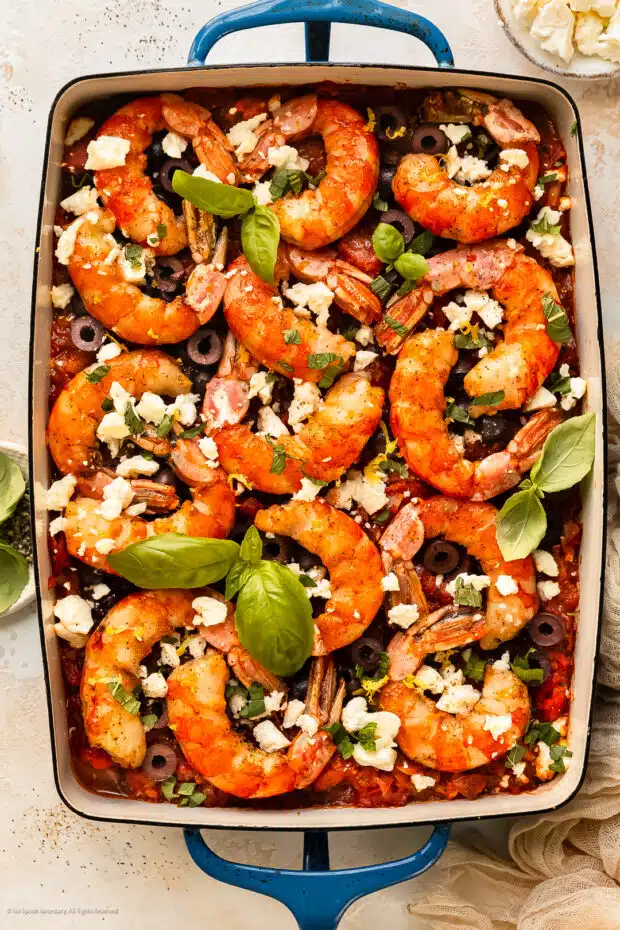
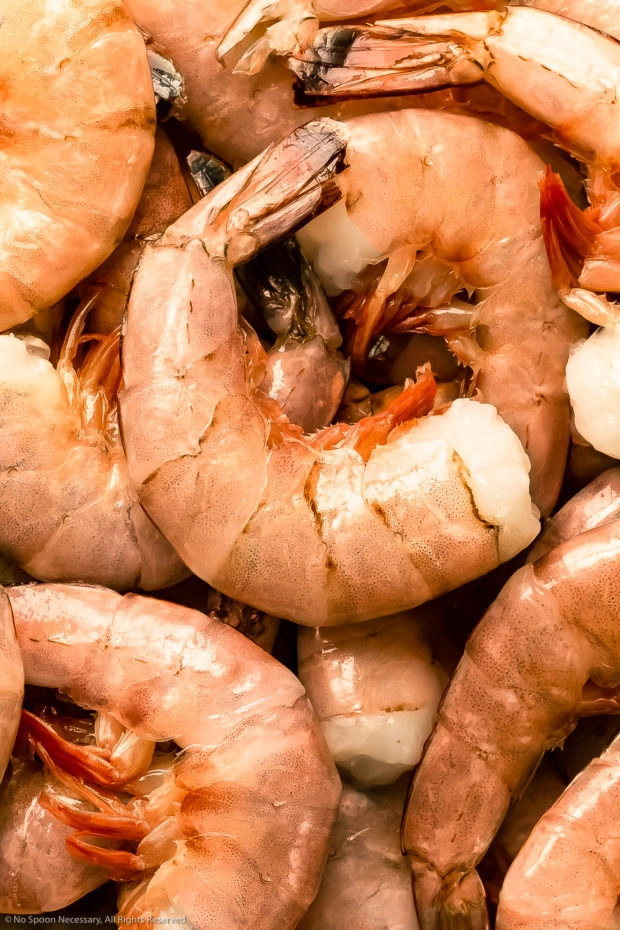
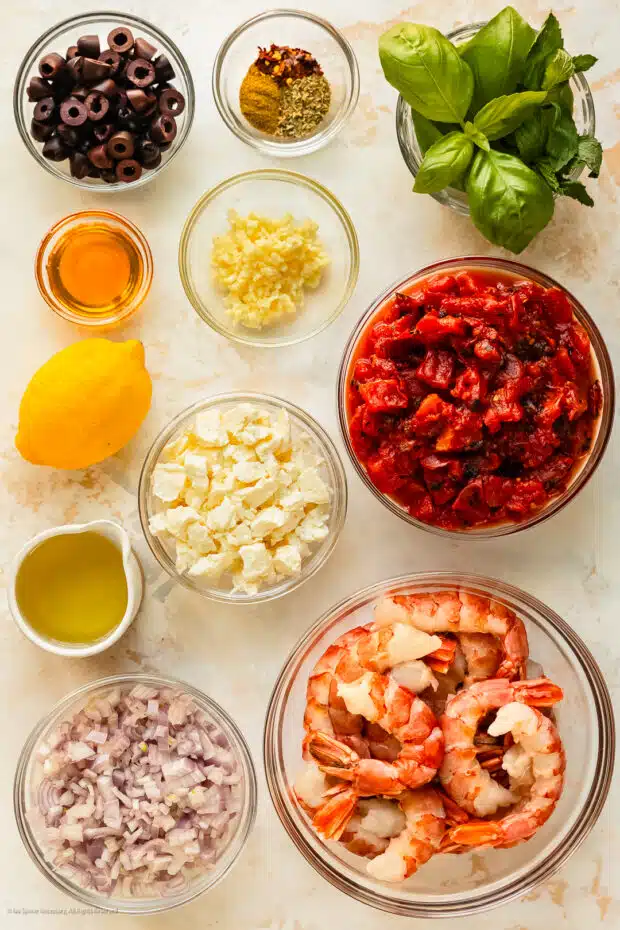
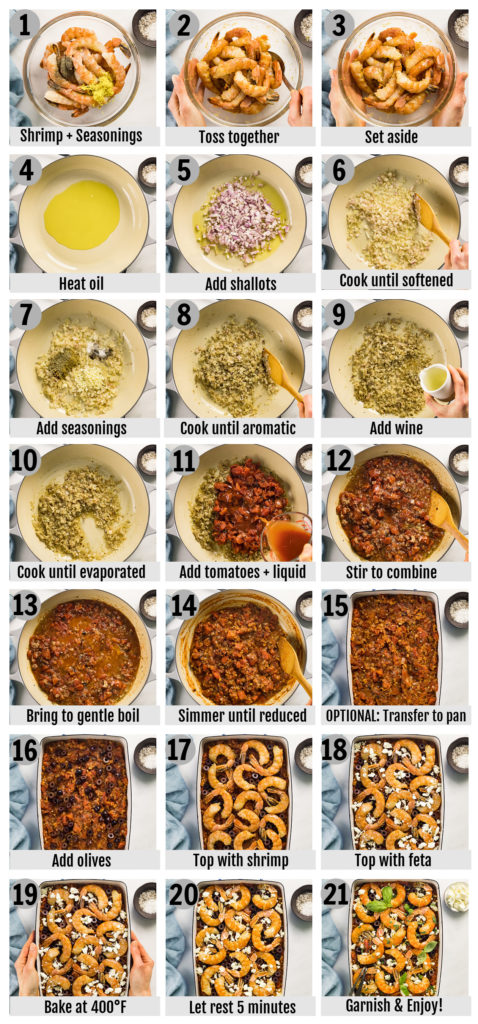
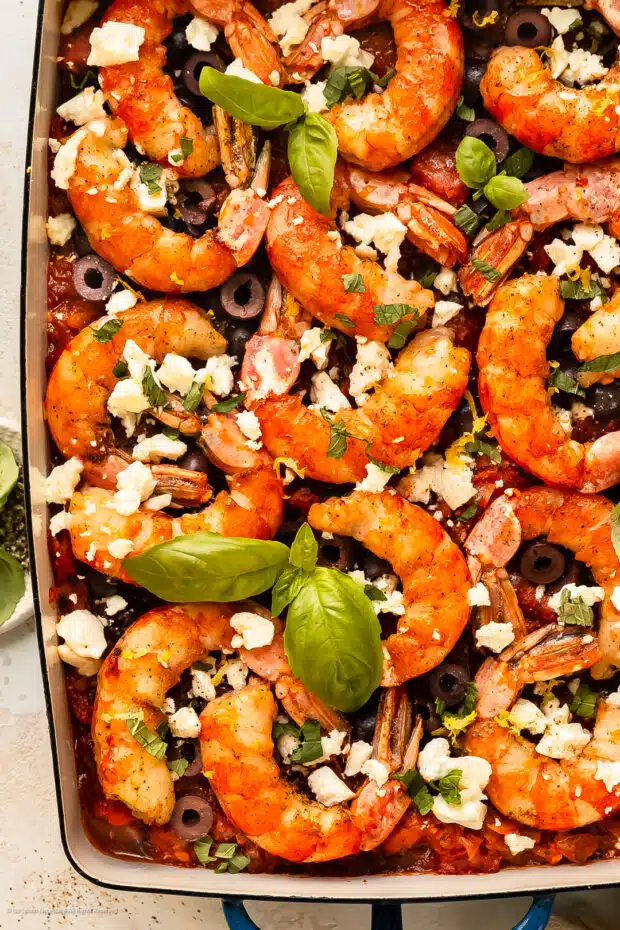

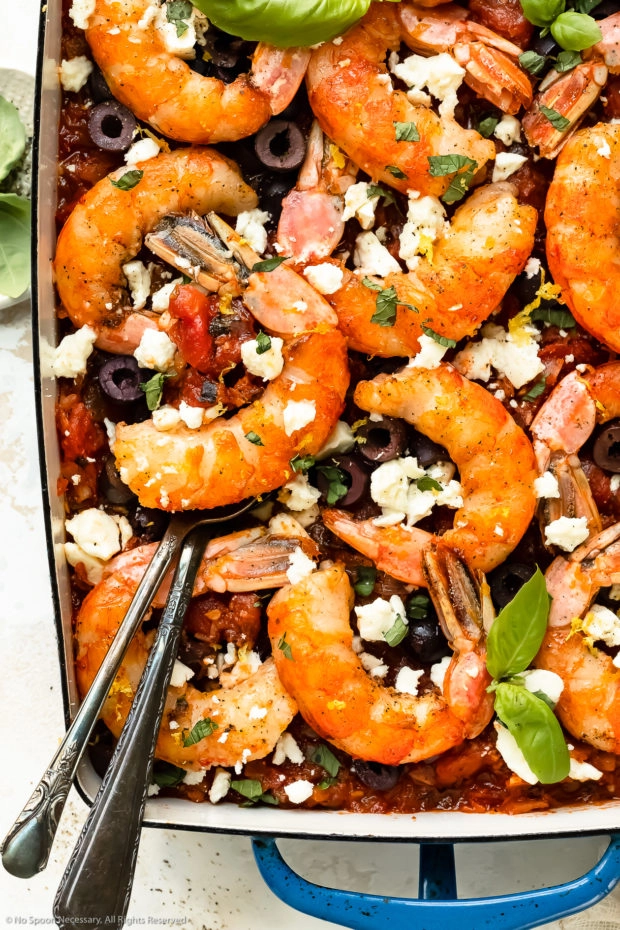
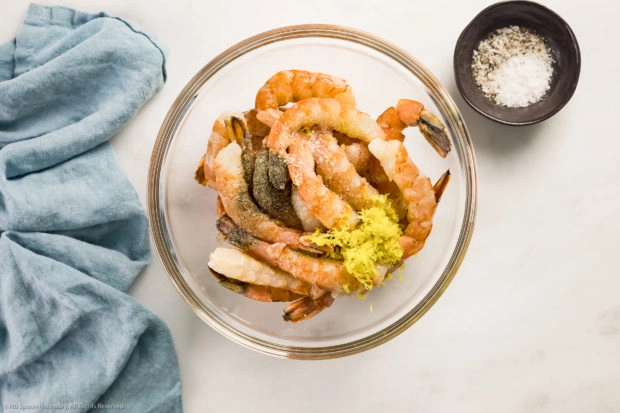
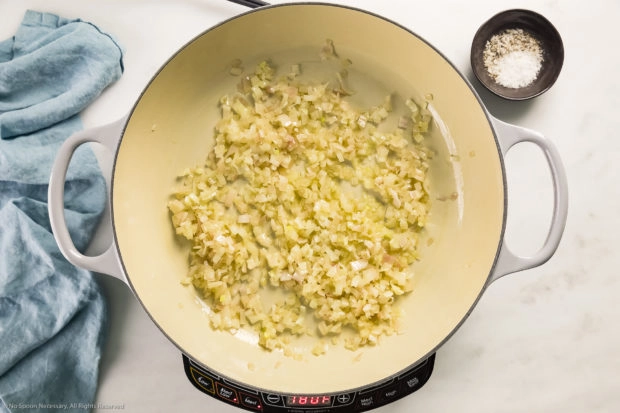
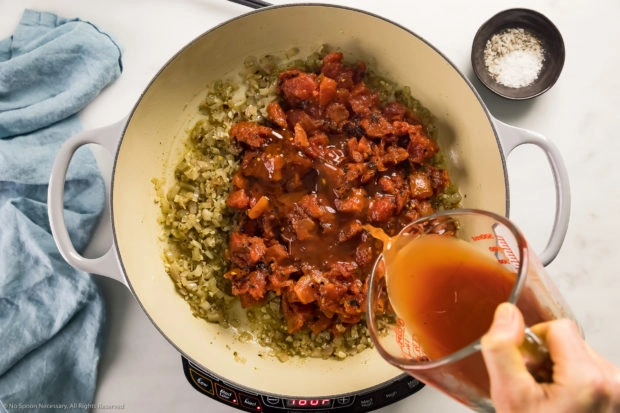
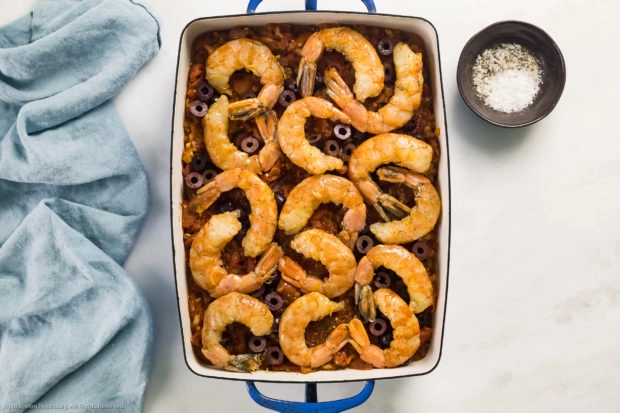
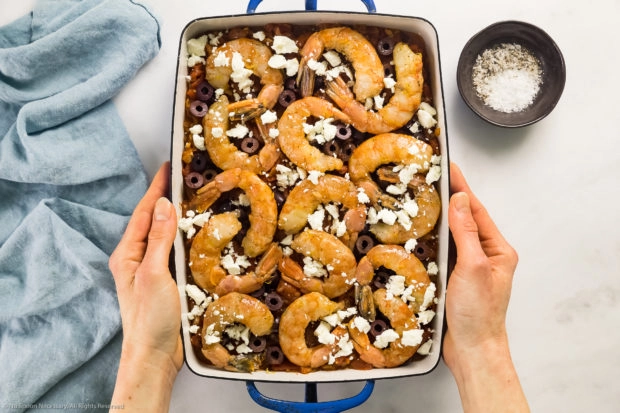
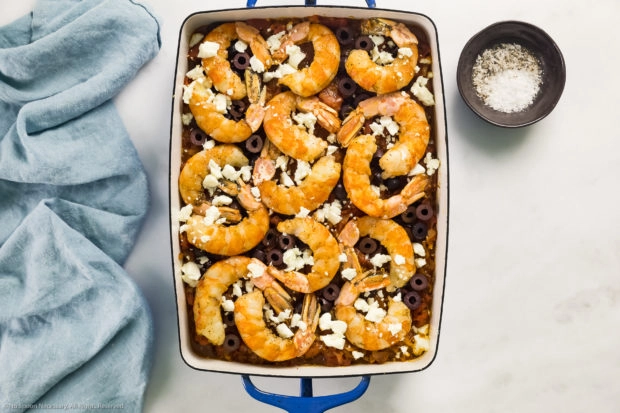
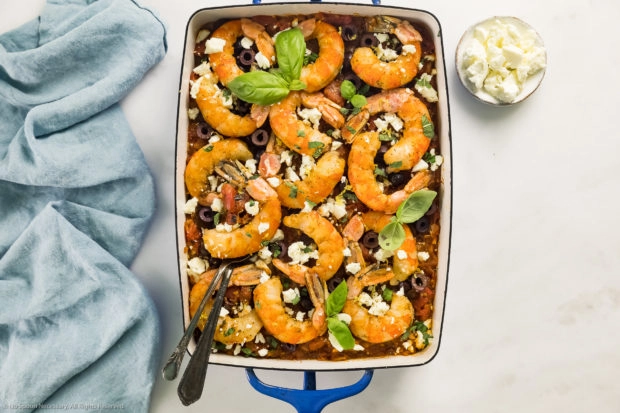
Alena
Amazing. I need these in my life, what awesome idea. Making this recipe for sure.
Carol R
O.M.G. This dish is most awesome. Scaled recipe for 2 servings and appreciated the capability to do that. DH had never had cooked kalamata olives before and wants more (sliced not halved) in each bite, the next time I make this. The depth of flavour is amazing, even though I did forget to include the fresh basil. Grated the lemon over the oil to allow all the lemon fragrance/oil to flavour the marinade. Have cooked a wide variety of recipes and this was exceptional. Very glad that he found this recipe and sent it to me, I look forward to making more of your recipes.
Cheyanne
Hi Carol,
I’m so happy to hear you were able to easily scale the recipe to feed 2 people! And, I’m absolutely thrilled to hear you enjoyed this dish so much!! Full disclosure, I tend to go heavy handed with the kalamata olives when I make this for myself, so I’m happy to hear I’m not alone in my love for (sliced!!) kalamata olives!! 🙂
Thank you so much for coming back and letting me know how everything went over! If you try more recipes, I certainly hope you love them as much as you loved this one! Cheers and warm wishes for a wonderful week!
mimi rippee
huh. why have I never heard of this! It’s fabulous! thanks.
Jennifer @ Seasons and Suppers
I’ve been on a shrimp kick lately, so this is right up my alley! Greek flavours are always a hit around here, too 🙂
Marissa
How did you know that I’ve been craving shrimp, Chey? And this dish looks like a flavor bomb! We love absolutely every ingredient. Putting this on next week’s menu!
Ben | Havocinthekitchen
Look at this gorgeous, meaty, and juicy shrimp! I can eat this as an appetizer, for main course, and probably instead of dessert too 🙂 I don’t think I’ve ever paired shrimp with sun-dried tomatoes, and I think I’m missing out a lot.
Mary Ann | The Beach House Kitchen
This is the time of year, I gather up new dishes for guests at beach during the summer. I will most definitely be adding this one to my list Chey. We LOVE shrimp dishes and I love all the ingredients!
angiesrecipes
Those jumbo prawns look so FRESH and yummy. A simple marinade goes a long way.